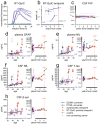This is a preprint.
Biomarker changes preceding symptom onset in genetic prion disease
- PMID: 38196583
- PMCID: PMC10775317
- DOI: 10.1101/2023.12.18.23300042
Biomarker changes preceding symptom onset in genetic prion disease
Update in
-
Fluid Biomarkers in Individuals at Risk for Genetic Prion Disease up to Disease Conversion.Neurology. 2024 Jul 23;103(2):e209506. doi: 10.1212/WNL.0000000000209506. Epub 2024 Jun 19. Neurology. 2024. PMID: 38896810 Free PMC article.
Abstract
Importance: Genetic prion disease is a universally fatal and rapidly progressive neurodegenerative disease for which genetically targeted therapies are currently under development. Preclinical proofs of concept indicate that treatment before symptoms will offer outsize benefit. Though early treatment paradigms will be informed by the longitudinal biomarker trajectory of mutation carriers, to date limited cases have been molecularly tracked from the presymptomatic phase through symptomatic onset.
Objective: To longitudinally characterize disease-relevant cerebrospinal fluid (CSF) and plasma biomarkers in individuals at risk for genetic prion disease up to disease conversion, alongside non-converters and healthy controls.
Design setting and participants: This single-center longitudinal cohort study has followed 41 PRNP mutation carriers and 21 controls for up to 6 years. Participants spanned a range of known pathogenic PRNP variants; all subjects were asymptomatic at first visit and returned roughly annually. Four at-risk individuals experienced prion disease onset during the study.
Main outcomes and measures: RT-QuIC prion seeding activity, prion protein (PrP), neurofilament light chain (NfL) total tau (t-tau), and beta synuclein were measured in CSF. Glial fibrillary acidic protein (GFAP) and NfL were measured in plasma.
Results: We observed RT-QuIC seeding activity in the CSF of three E200K carriers prior to symptom onset and death, while the CSF of one P102L carrier remained RT-QuIC negative through symptom conversion. The prodromal window of RT-QuIC positivity was one year long in an E200K individual homozygous (V/V) at PRNP codon 129 and was longer than two years in two codon 129 heterozygotes (M/V). Other neurodegenerative and neuroinflammatory markers gave less consistent signal prior to symptom onset, whether analyzed relative to age or individual baseline. CSF PrP was longitudinally stable (mean CV 10%) across all individuals over up to 6 years, including at RT-QuIC positive timepoints.
Conclusion and relevance: In this study, we demonstrate that at least for the E200K mutation, CSF prion seeding activity may represent the earliest detectable prodromal sign, and that its prognostic value may be modified by codon 129 genotype. Neuronal damage and neuroinflammation markers show limited sensitivity in the prodromal phase. CSF PrP levels remain stable even in the presence of RT-QuIC seeding activity.
Figures

References
-
- Schmitz M, Villar-Piqué A, Hermann P, Escaramís G, Calero M, Chen C, Kruse N, Cramm M, Golanska E, Sikorska B, Liberski PP, Pocchiari M, Lange P, Stehmann C, Sarros S, Martí E, Baldeiras I, Santana I, Žáková D, Mitrová E, Dong XP, Collins S, Poleggi A, Ladogana A, Mollenhauer B, Kovacs GG, Geschwind MD, Sánchez-Valle R, Zerr I, Llorens F. Diagnostic accuracy of cerebrospinal fluid biomarkers in genetic prion diseases. Brain. 2022. Apr 18;145(2):700–712. - PMC - PubMed
-
- Staffaroni AM, Kramer AO, Casey M, Kang H, Rojas JC, Orrú CD, Caughey B, Allen IE, Kramer JH, Rosen HJ, Blennow K, Zetterberg H, Geschwind MD. Association of Blood and Cerebrospinal Fluid Tau Level and Other Biomarkers With Survival Time in Sporadic Creutzfeldt-Jakob Disease. JAMA Neurol. 2019. May 6; - PMC - PubMed
-
- Abu-Rumeileh S, Halbgebauer S, Bentivenga GM, Barba L, Baiardi S, Mastrangelo A, Oeckl P, Steinacker P, Mammana A, Capellari S, Otto M, Parchi P. High diagnostic performance of plasma and cerebrospinal fluid beta-synuclein for sporadic Creutzfeldt-Jakob disease. Ann Clin Transl Neurol. 2023. Oct;10(10):1904–1909. - PMC - PubMed
-
- Abu-Rumeileh S, Baiardi S, Ladogana A, Zenesini C, Bartoletti-Stella A, Poleggi A, Mammana A, Polischi B, Pocchiari M, Capellari S, Parchi P. Comparison between plasma and cerebrospinal fluid biomarkers for the early diagnosis and association with survival in prion disease. J Neurol Neurosurg Psychiatry. 2020. Sep 14; - PubMed
-
- Vallabh SM, Minikel EV, Williams VJ, Carlyle BC, McManus AJ, Wennick CD, Bolling A, Trombetta BA, Urick D, Nobuhara CK, Gerber J, Duddy H, Lachmann I, Stehmann C, Collins SJ, Blennow K, Zetterberg H, Arnold SE. Cerebrospinal fluid and plasma biomarkers in individuals at risk for genetic prion disease. BMC Med. 2020. Jun 18;18(1):140. - PMC - PubMed
Publication types
Grants and funding
LinkOut - more resources
Full Text Sources
Research Materials
Miscellaneous
